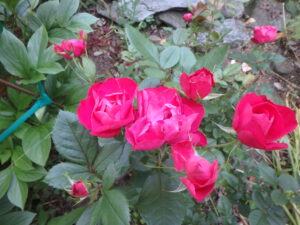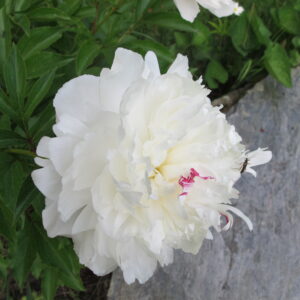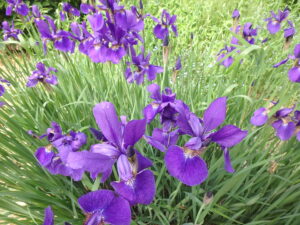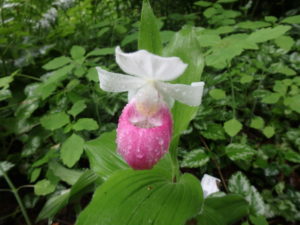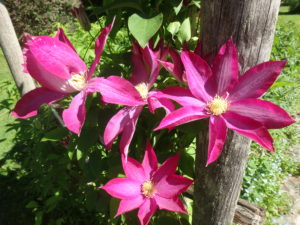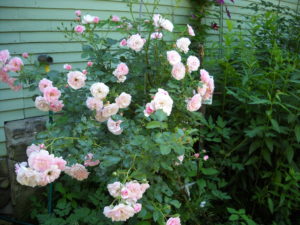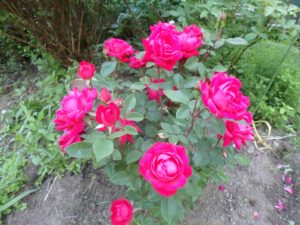Growing Roses and More
My favorite roses are part of the “Knockout” series of roses, though I know others who really like the “Easy Elegance” series. They do not grow blossoms on long stems, but have multiple blossoms per stem. My “Knockouts” start blooming in June, bloom all summer, and up until hard frost – or even later.
Want more blossoms? Roses do better if they get some fertilizer a few times during the course of the summer. An organic, slow-release bagged fertilizer called Rose Tone is designed just for roses, but I use Pro-Gro, my go-to organic fertilizer and sometimes use liquid fish and seaweed fertilizers made by Neptune’s Harvest. I add half a cup of Pro-Gro to the hole when I plant.
Siberian iris only bloom for a few days, but are magnificent. They come in a variety of blues and purples. Old patches tend to develop a dead spot in the middle because the plants have used up all the soil nutrients. Divide in the fall and re-plant, or add some organic fertilizer now.
Flowers in Bloom That Make Me Want to Swoon
My earliest memory of a flower dates back to spring, 1948, when I was just 2 years old and living in Hingham, Massachusetts (we moved away that fall, so I know the year). My mother, sister and I were walking through a pine woods when we encountered a cluster of pink ladyslipper orchids. I was enchanted. I wanted to pick it. My mom restrained me, saying it was a rare and special flower. I am still overwhelmed by their beauty, and feel lucky I can grow 2 kinds of ladyslippers.
There are 3 main types of ladyslippers that grow in the Northeast. A yellow ladyslipper (Cypripedium parviflorum), the pink one that I saw when young (Cypripedium acaule), and a bigger pink one called the showy ladyslipper (Cypripedium reginae). I grow the yellow and the showy.
The pink ladyslipper is tough to grow – it requires very acidic soil and is nearly impossible to transplant. In the wild I have only seen them in sandy soil under white pines.
The yellow and showy ladyslippers do fine in moist, rich soil and moderate shade. It is now possible to buy them at specialty nurseries. Some nurseries grow them and divide big clumps to sell individual plants. Starting any ladyslipper by seed is generally considered nearly impossible.
What other flowers now in bloom make my heart go Ka-Boom? My Japanese primroses, also called candelabra primroses (Primula japonica). I’ve grown these in the shade of some wild apple trees where the soil is rich, black and moist. Starting with just 7 plants, these have dropped seeds and self-planted so that I now have hundreds after 20 years. They are finishing up their bloom cycle now.
Candelabra primroses range in color from a deep magenta to medium pink to nearly white. They bloom up their stalks, presenting a ring of florets, then a second, third and sometimes even a fourth or fifth set of blossoms. Because they don’t all bloom at once, they flower for up to a month, depending on the heat.
Then there are the peonies. I have one, a division of my grandmother’s favorite, called ‘Festiva Maxima’. Grandmother died in 1953, and my mother dug it up and brought it to my childhood home. Then in the 1980’s I dug it up, divided it and brought some of it to New Hampshire. It is a double white with a speck of red in the middle. What makes it so special is the fragrance. It is enough to make the weak-hearted swoon.
If you don’t have a peony, or don’t have several, go buy one now when you can see the blossoms and judge the fragrance. Not all peonies have fragrance. Be sure not to plant it too deep. The ‘eyes’ or growing points need to be within an inch of the soil line. Otherwise they will grow and look healthy, but fail to bloom. Plant them with plenty of compost and some organic fertilizer added to a large planting hole.
I love roses. For ages roses bloomed mostly in June and suffered from black spot, Japanese beetles and other difficulties. No more. You can get roses that require no chemicals to stay healthy and bloom much of the summer. The only problem is that most of these modern hybrids have little or no scent.
Of the modern hybrids my favorite is the “Knockout” series. I have had singles and doubles, and find most are as hardy as a shovel (though much prettier). And I’ve had them bloom all summer and past Halloween.
But what I really love are the old fashioned roses. Many of them send up side shoots from the ground that can be dug and passed on. I have two of these, and I don’t know their varieties. I have a double white and a double pink, both with lovely scent. And despite the fact that I am an organic gardener who doesn’t spray them, they seem to stay free of pests and diseases.
I grow 5 kinds of clematis, and all are wonderful. Most clematis die back to the ground each winter, and start up in spring, though a few have hardy vines. Most grow 6 to 10 feet in length and need something tall to climb up. They have big, bodacious blossoms. Most are not particularly fragrant. They bloom in shades of pink and purple, along with white. The two I have in bloom right now have flat 6-petaled blossoms 4 to 5 inches in diameter. The most durable and vigorous is a purple one called Clematis jackmanii.
The trick to succeeding with clematis is to remember the old adage, they like “hot tops and cool bottoms.” The vines need to be in full sun, or full afternoon sun, and the roots need to be shaded. Plant something right in front of the clematis to help keep the roots cool.
June really is the best month for flowering plants. All those I mentioned above – and dozens of others – grace us with their presence. Go to a good family-run nursery where the staff really knows the habits of the plants and can tell you about each one. Most really enjoy educating you about the flowers, so ask questions. Of course, the best teacher is experience. So go get some new perennials and enjoy them.
Henry is a UNH Master Gardener, and the author of 4 gardening books. He lives in Cornish Flat, NH.
Tips for Growing Better Roses This Summer
My grandmother and mom grew roses, even though their roses were often plagued by bugs and diseases. But in recent years the rose industry has produced a number of carefree roses that anyone with 6 hours of sunshine and even a slightly green thumb can grow.
Probably the first place to start a quest for a great rose would be at a good family-run garden center. Find the rose expert there, and ask about good varieties for your area. In general, fragrant roses tend to attract Japanese beetles and other insect pests. I personally like the ‘Knock Out” rose series. These roses are highly disease resistant and, in my experience, they attract few pest bugs. There are other disease-resistant varieties, of course.
If you live in a cold place where winters reach minus 25 or more, I’d look at the Canadian Explorer series of roses. These were developed in Ottawa, Canada and include those tough rugosa roses in their gene pool. Rugosa roses are also called beach roses, since they often grow in pure sand on the dunes of Cape Cod and elsewhere.
A good resource for selecting and maintaining problem-free roses is a book I like very much, Roses for New England: A Guide to Sustainable Rose Gardening by Mike and Angelina Chute. This book is full of information relevant to New England gardeners, and reading it would be a good way to educate yourself about roses. It reinforces what I have learned about roses over the years – and taught me some things I didn’t know.
So what do roses want? Good soil with a slightly acidic pH, plenty of sunshine, soil that is slightly moist all the time, a little fertilizer, and someone who loves them and is willing to pull off the beetles and drown them.
The soil that roses want is a good loam amended with compost. Dig a hole that is about two and a half feet wide and 18 inches deep. Keep half the soil and mix it with an equal amount of compost in a wheelbarrow or on a tarp.
You could send away a soil sample to determine the soil pH and to see what minerals are deficient, though that might take a few weeks before you get a response. Or you could just go to your local garden center and buy a kit for testing soil pH. Much of New England has acidic soil, but roses like something in the range of 6.0 to 6.8 – slightly acidic.
You can improve your soil pH by mixing in limestone (which is available in bags at your garden center). Mixing in a cup per rose is a good start, depending on your soil pH. I knew a rosarian who always buried a 4 inch square scrap of Sheetrock (wallboard) beneath each rose to provide calcium and improve soil pH over time. A cup of bone meal or rock phosphate at planting time will add phosphate, a mineral that roses need.
Roses need sunshine to do well, the more the better. The Chute’s book taught me that if you have to choose morning sun or afternoon sun, go for morning sun. That way the dew dries up more quickly – and fungal diseases, which love wet leaves, are minimized naturally. Six hours of sun is considered adequate, but the Chutes mention that roses with fewer petals need less sun to bloom.
I have a rose right near my front door – and the hose that is connected there. It has bloomed well for decades, in part, because every time I fill a bucket, wash the car or use the hose, I give the rose a nice drink. Roses love water. I have a watering wand on the hose so that I can direct water to its base, and not wet the leaves. In dry summers watering roses is key. How much? At least 5 gallons per week for a mature rose.
I rarely fertilize my roses, but the Chute’s book says that fertilizing regularly increases blooming. I might try a couple of applications of an organic liquid fish fertilizer this summer. Be aware that too much fertilizer pushes fast growth that is more susceptible to diseases and insect damage.
What else should you consider when selecting roses? I like roses grown on their own roots, not grafted onto root stock. If the plant dies down to the soil over winter, a rose will sometimes send up shoots from the roots, which are different from the rose you planted if you buy grafted roses.
Also read the tag carefully to see if it is a one-time bloomer each season, or a re-bloomer. Some roses like the Knock-Out roses bloom for most of the summer. Be sure to cut off blossoms after flowering to encourage more blossoms.
Finally, now is the season to cut off any brown, dead portions on stems – most roses suffer a little winter damage. Cut above an emerging leaf.
I’m an organic gardener which means I don’t spray my roses, not for fungal diseases, not for insect pests. I firmly believe that if you have a rose in good soil with good sunshine and adequate water, your roses will be healthy and not attract many insects.
Henry is at the Chelsea Flower Show in London this week, and will not be answering questions. Read his report on the show next week!



